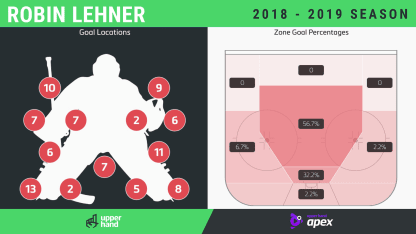Seven hole:The number that should probably jump out a little more are the 10 goals under Murray's blocker-side arm, double the average (4.8 percent) and something that's been previously noted. Murray's blocker position, with his right elbow sticking out to keep the stick blade on the ice even in blocking situations, led to more goals under the arm and between the blocker in his first two seasons, and while they dropped last year, they're back up this season.
Clean shots: Murray was near or better than average on screens, deflections, rebounds, lateral plays and one-timers, but he allowed 34 goals on clean shots on which he had time to get set. That's above the 22.9 percent average and the highest tracked total this season. They accounted for five of the 10 goals under the blocker-side arm compared to 11 of 27 mid-to- high-glove, and for 23 of 44 rush goals. Some of this may be his tendency to retreat flat to the goal line on rush chances down the wing, which can cause him to lose squareness. There is a lowering and widening of his stance on these plays, which can leave him locked in a little early and makes it harder to react into shots.
Blocker side: Perhaps more surprising is the amount of goals scored from outside the home-plate area on Murray's right (14, compared to six on the glove side). This could be little more than facing more high-quality chances from his right, but that would require tracking every shot to create a save percentage for each zone. Murray was a rare goalie who moved better to his blocker side in the past, and while some of that early rotation into angle seems to have been lost, it's still surprising to see him get beat more from that side.




















